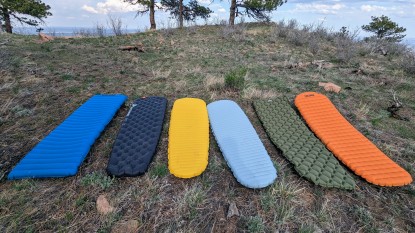The Nemo Cosmo is a wider and longer version of the company's Astro sleeping pad. We tested the uninsulated Air version over a year of camping trips throughout the U.S., on a 6-week bike tour down Mexico's Baja Peninsula, and in Puerto Rico. The pad was once one of the best in its class—the class that blends extra comfort and extra durability— but newer entrants now outshine the Cosmo and it scores in the lower quarter of the pads we've tested.
Check out our comprehensive Backpacking Sleeping Pad Review to compare all of the models tested. If you're interested in a pad with extra comfort consider the Therm-a-Rest NeoAir Camper.Nemo Cosmo Air Review
Our Verdict
Our Analysis and Test Results
Performance Comparison
Weight
The Cosmo Air weighs a hefty 29.6 ounces on our scale. That's almost as much as some ultralight backpacking tents and it's more than most top-tier 15-degree down sleeping bags. Thus, we feel that this pad is too heavy for backpacking; our testers primarily used it for camping.
Packed Size
The pad packs down surprisingly small considering its size when inflated.
Durability
The Cosmo uses thick, durable fabrics that are tougher than those used on the Therm-a-Rest NeoAir Xlite pad.
Comfort
The Cosmo's increased length and width compared to the average 20" x 72" pad increases comfort significantly. However, the built-in pillow is a terrible detriment for taller people, and most other people. None of our testers liked the pillow. One said, "It gave the pad directionality, which is often inconvenient. I would prefer a totally flat surface to sleep on because usually I use spare clothing or a jacket as my pillow. Also, I prefer to put my arms around the pillow, which was not possible with this one."
If you're around 5' 10" tall you need to slide down below the pillow to lay your head on the flat part of the pad. That pushes your feet off the end.
Related to comfort, the pad has a built-in foot pump for inflation. Nemo's aim here was to make it easier, i.e. more comfortable, to inflate the pad. But neither of the pumps on the two Cosmo Air pads we tested work well. One tester, who used the pad on a 6-week bike tour down Mexico's Baja Peninsula, reported back with the following:
"The foot pump should be considered a hand pump. I always had to kneel over and pump it with my hands. This is because, first, the valve was not entirely one way so with each pump a noticeable amount of air would leak out during the push in. While pushing I had to cover the valve with my hands to make them more efficient. Also, given that we were always camping on thorny dirt or in sand, I chose to pump the pad in the tent, which meant I could not stand and use the pump as a foot pump. Pumping with my hands would oftentimes leave my hands sore, especially after a day of biking. If my hands were any smaller it would be difficult to pump with just hands."
We believe the pad would be better without the pump and without the pillow.
Warmth
The Cosmo air is a summer pad. Nemo also has an insulated version that could extend the range into chilly spring and fall weather.
Best Applications
Car camping.
Value
Other pads offer more comfort for a lower price and many pack to a similar size and weigh a similar amount.
Conclusion
The Cosmo Air was once among the best compact camping pads but others companies have released new models that perform better.




